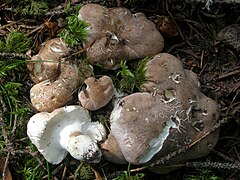Albatrellus
| Albatrellus | |
|---|---|

| |
| Albatrellus ovinus | |
| Scientific classification | |
| Domain: | Eukaryota |
| Kingdom: | Fungi |
| Division: | Basidiomycota |
| Class: | Agaricomycetes |
| Order: | Russulales |
| Family: | Albatrellaceae |
| Genus: | Albatrellus Gray (1821) |
| Type species | |
| Albatrellus ovinus | |
| Synonyms[1] | |
Albatrellus is a genus of 19 species of mushroom-producing fungi in the family Albatrellaceae.[3] Species are common in northern temperate forests, producing medium to large fleshy fruit bodies of various colors.
Taxonomy
[edit]British botanist Samuel Frederick Gray first described the genus in his 1821 work "A Natural Arrangement of British Plants".[4]
Parsimony analysis of internal transcribed spacer sequences of various Albatrellus species show that the genus is not monophyletic, and that the species may be divided into two clades.[5] This corroborates prior phylogenetic analysis that suggested that Albatrellus consists of two separate groups with affinity to the Russuloid and Polyporoid clades.[6][7][8]
Description
[edit]Species of Albatrellus are terrestrial, with fleshy fruit bodies that differentiate into caps and stipes; the stipe is either central or eccentric to lateral. Fruit bodies are solitary or in clusters with stem bases or cap margins fused. Context mostly tough-fleshy, white or becoming brightly colored. The hymenophore is regularly poroid. The hyphal system is monomitic, the generative hyphae septate with or without clamp connections, with thin or somewhat thick, amyloid or inamyloid, indextrinoid and acyanophilous walls; the majority of hyphae are distinctly inflated (the fundamental hyphae). The basidiospores are ellipsoid to roughly spherical in shape, thin-walled to slightly thick-walled, with smooth, amyloid or inamyloid, indextrinoid and acyanophilous walls.[9]
Distribution
[edit]Twelve species of Albatrellus occur in North America.[10] The edible Albatrellus ovinus is sold commercially in Finland.[11] The Dictionary of the Fungi estimates there to be 16 species in the genus, but three new species (A. fumosus, A. microcarpus, A. tibetanus) were described from China in 2008.[12]
Species
[edit]
- Albatrellus avellaneus
- Albatrellus borneensis
- Albatrellus caeruleoporus (edible)[13]
- Albatrellus cantharellus
- Albatrellus citrinus[14]
- Albatrellus cochleariformis
- Albatrellus confluens
- Albatrellus congoensis
- Albatrellus cristatus
- Albatrellus ellisii
- Albatrellus flettii
- Albatrellus fumosus
- Albatrellus ginnsii
- Albatrellus hirtus
- Albatrellus microcarpus
- Albatrellus ovinus
- Albatrellus peckianus
- Albatrellus piceiphilus
- Albatrellus pilosus
- Albatrellus similis
- Albatrellus skamanius
- Albatrellus subrubescens
- Albatrellus syringae
- Albatrellus tianschanicus
- Albatrellus tibetanus
- Albatrellus yasudae
- Albatrellus yunnanensis
References
[edit]- ^ "Albatrellus Gray". MycoBank. International Mycological Association. Retrieved 2013-01-27.
{{cite journal}}: Cite journal requires|journal=(help) - ^ Teixera A.R. (1993). "Chave para identificação dos gêneros de Polyporaceae com base na morfologia dobasidiocarpo". Boletim do Instituto de Botânica de São Paulo (in Portuguese). 8: 1–55.
- ^ Kirk PM, Cannon PF, Minter DW, Stalpers JA (2008). Dictionary of the Fungi (10th ed.). Wallingford, UK: CAB International. p. 18. ISBN 978-0-85199-826-8.
- ^ Gray S.F. (1821). A Natural Arrangement of British Plants. Vol. 1. London, UK: Cradock, and Joy. p. 645.
- ^ Cui BK, Wang Z, Dai YC (2008). "Albatrellus piceiphilus sp nov on the basis of morphological and molecular characters" (PDF). Fungal Diversity. 28: 41–8.
- ^ Gardes M, Bruns TD (1993). "ITS primers with enhanced specificity for basidiomycetes—application to the identification of mycorrhizae and rusts". Molecular Ecology. 2 (2): 113–8. doi:10.1111/j.1365-294X.1993.tb00005.x. PMID 8180733. S2CID 24316407.
- ^ Hibbett DS, Pine EM, Langer E, Langer G, Donoghue MJ (1997). "Evolution of gilled mushrooms and puffballs inferred from ribosomal DNA sequences". Proceedings of the National Academy of Sciences of the United States of America. 94 (22): 12002–6. Bibcode:1997PNAS...9412002H. doi:10.1073/pnas.94.22.12002. PMC 23683. PMID 9342352.
- ^ Larsson E, Larsson KH (2003). "Phylogenetic relationships of russuloid basidiomycetes with emphasis on aphyllophoralean taxa". Mycologia. 95 (6): 1037–65. doi:10.2307/3761912. JSTOR 3761912. PMID 21149013.
- ^ Pouzar Z. (1966). "Studies in the Taxonomy of the Polypores II". Folia Geobotanica & Phytotaxonomica. 1 (4): 356–75. doi:10.1007/BF02854587. S2CID 32153026.
- ^ Ryvarden L; Gilbertson RL (1986). North American Polypores. Oslo, Norway: Fungiflora. ISBN 0-945345-06-2.
- ^ Pelkonen R, Alfthan G, Järvinen O (2008). Element Concentrations in Wild Edible Mushrooms in Finland (PDF). Helsinki, Finland: Finnish Environment Institute. p. 32. ISBN 978-952-11-3153-0. Retrieved 2009-02-20.
- ^ Zheng HD, Liu PG (2008). "Additions to our knowledge of the genus Albatrellus (Basidiomycota) in China" (PDF). Fungal Diversity. 32: 157–70.
- ^ Phillips, Roger (2010). Mushrooms and Other Fungi of North America. Buffalo, NY: Firefly Books. p. 295. ISBN 978-1-55407-651-2.
- ^ Ryman S, Fransson P, Johannesson H, Danell E (2003). "Albatrellus citrinus sp. nov., connected to Picea abies on lime rich soils". Mycological Research. 107 (10): 1243–6. doi:10.1017/S0953756203008359. PMID 14635772.
Extensive comparative discussion of some species at Albatrellus subrubescens
